Azure Kubernetes Service (AKS)
Overview
Kubernetes is an open-source container orchestration tool, It ensures scalability and stability by automating containerized workloads. This power is brought to the cloud via Azure Kubernetes Service (AKS), Microsoft's managed Kubernetes service. AKS makes cluster management easier, allowing developers to focus on developing innovative cloud-native applications rather than worrying about infrastructure.
Kubernetes and AKS, when used together, enable organisations to realise the full potential of containers, increasing efficiency and agility in the volatile world of cloud computing. Accept this game-changing technology to open up new possibilities for frictionless, scalable, and efficient application deployment. In this article, we will go to learn about Azure Kubernetes service and leverage the power of AKS.
Azure Kubernetes Service (AKS)
Microsoft's Azure Kubernetes Service (AKS) is like having a super helpful team to manage your containers for you. You don't have to worry about all the complicated stuff like setting up and maintaining the background systems. Instead, you can use Kubernetes to easily put your applications into containers and let Azure Kubernetes Service (AKS) handle the rest. It takes care of installing, updating, and looking after the Kubernetes cluster so that developers can focus on building and managing your app without any worries. It's like having a supportive team that runs your apps in the cloud.
Features of AKS
-
Managed Kubernetes: Azure Kubernetes services takes care of the Kubernetes cluster's installation, scaling, and upgrades, making it simple to deploy and administer containerized applications.
-
Integration with Azure Services: To improve monitoring, logging, and security capabilities, Azure Kubernetes service connects seamlessly with several Azure services, including Azure Monitor, Azure Log Analytics, and Azure Active Directory.
-
Auto Scaling: AKS(Azure Kubernetes Service) can dynamically adjust the cluster's node count in response to workload demand, making sure your applications can cope with rising traffic or resource needs.
-
Self-Healing: To keep the application in the correct condition when a container or node fails, AKS automatically replaces it or reschedules it.
-
Networking and Load Balancing: AKS(Azure Kubernetes Service) includes networking and load balancing functionality, enabling simple container communication and dividing incoming traffic among them.
-
Automatic node provisioning: By automatically adding nodes to your cluster, AKS relieves you of the responsibility of maintaining the supporting infrastructure.
Benefits of Azure Kubernetes Service
-
Simplified management: AKS abstracts away the difficulties of overseeing Kubernetes clusters, allowing developers to concentrate on creating and delivering applications.
-
Scalability: AKS offers seamless application and infrastructure scaling to efficiently manage changing workloads.
-
Dependability: With self-healing and automated recovery techniques, AKS ensures high availability and dependability of applications.
-
Security: To ensure safe access and identity management, Azure Kubernetes makes use of Azure's security features, including integration with Azure Active Directory and role-based access control (RBAC).
-
Cost-effectiveness: With pay-as-you-go pricing that only charges you for the resources you use, AKS provides a cost-effective option to operate Kubernetes.
Architecture of AKS
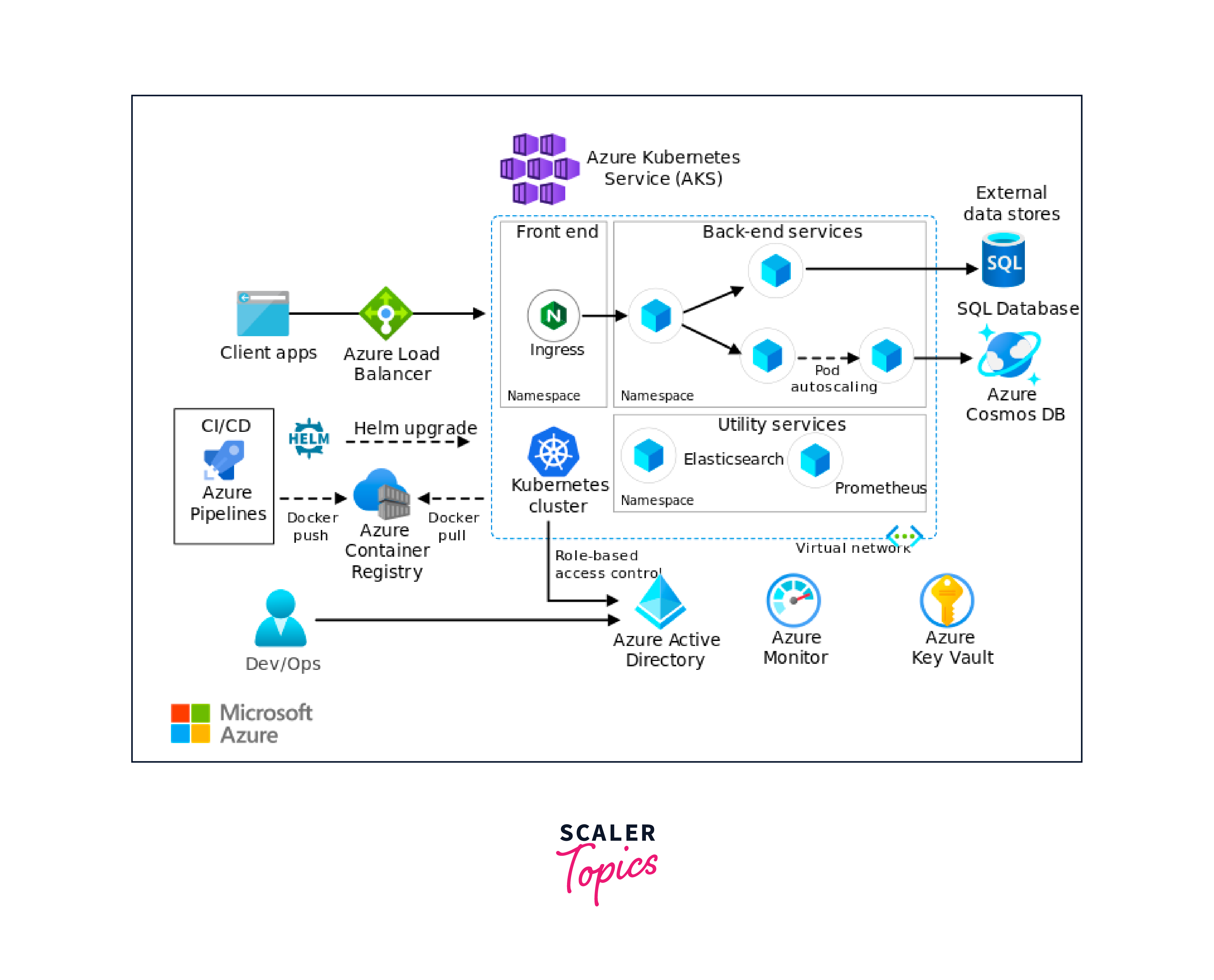
-
Azure Kubernetes Service (AKS): AKS is a managed Kubernetes cluster on the Azure cloud. Azure takes care of the Kubernetes API, and you only manage the agent nodes.
-
Virtual network: AKS creates a virtual network for agent nodes. It allows you to control subnet configuration, on-premises connectivity, and IP addressing.
-
Ingress: The ingress server exposes HTTP(S) routes to services inside the cluster, making them accessible from the internet.
-
Azure Load Balancer: Once your AKS cluster is set up, the load balancer is ready to use. It routes internet traffic to the ingress, ensuring proper distribution of requests.
-
External data stores: Microservices write state to external data stores like Azure SQL Database or Azure Cosmos DB since they are typically stateless.
-
Azure Active Directory: AKS uses Azure AD identity to manage Azure resources, like load balancers. It's also recommended for user authentication in client applications.
-
Azure Container Registry: Container Registry stores private Docker images used in the cluster. AKS can authenticate with it using its Azure AD identity.
-
Azure Pipelines: Part of Azure DevOps Services, Azure Pipelines handle automated builds, tests, and deployments. You can also use other CI/CD solutions like Jenkins.
-
Helm: Helm is a Kubernetes package manager that simplifies deploying, updating, and managing Kubernetes objects.
-
Azure Monitor: It collects and stores metrics, logs, and telemetry for Azure services, including AKS. Use this data for monitoring, setting up alerts, and analyzing failures.
Azure Kubernetes Services provides a managed Kubernetes environment on Azure, and with the help of various Azure services like Load Balancer, Active Directory, and Container Registry, you can build, deploy, and monitor your microservices-based applications efficiently.
Azure Kubernetes Services Use Cases
AKS is suitable for various use cases, including:
-
Microservices: AKS makes it easier to deploy and manage applications built on microservices.
-
Continuous Integration/Continuous Deployment (CI/CD): AKS offers CI/CD pipelines for automated application deployments, ensuring quick delivery of updates.
-
DevOps: By offering a standardised platform for application deployment, Kubernetes Azure makes it easier for development and operations teams to collaborate.
-
Containerized Application Deployment: Azure Kubernetes is widely used to deploy and manage containerized applications. It allows developers to package their applications into containers and run them efficiently at scale.
-
Supports agile project management: AKS(Azure Kubernetes Service) supports Agile development through rapid containerized app deployment, automated CI/CD, scalable infrastructure, isolated dev environments, A/B testing, IaC, monitoring, collaboration, and fast prototyping.
How to Set Up a Basic AKS Cluster?
Setting up a basic AKS cluster involves these general steps:
-
Create an Azure account first, then go to the Azure Portal and search for Kubernetes Service in the search bar.

-
Select the Kubernetes Services and once you have reached the** Azure Kubernetes services** click on create and then click on create Kubernetes Cluster.

-
Create an Azure Resource Group.
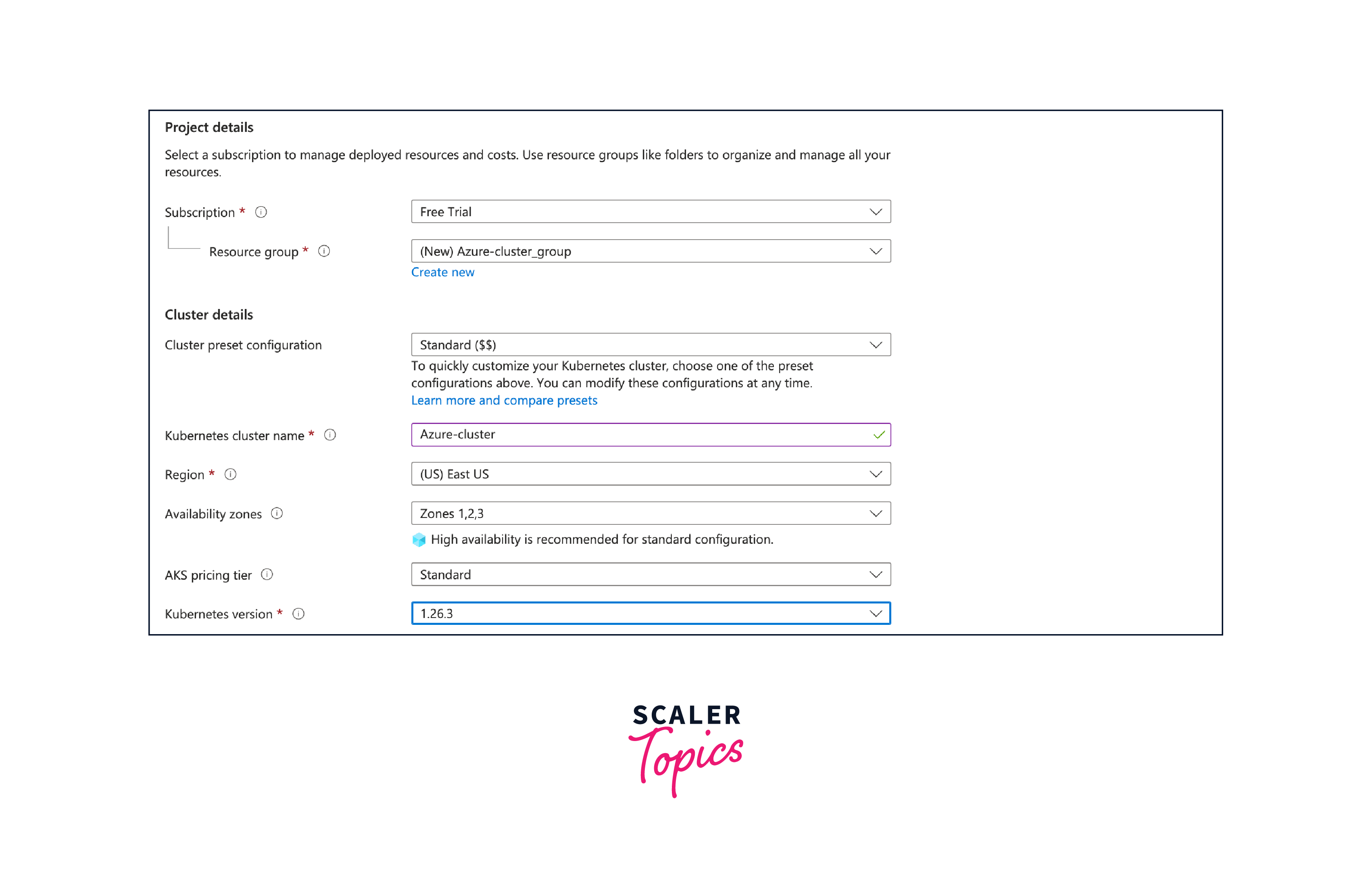
-
After completing the steps in the Node pool, click on the access option in order to create Authentication in azure Kubernetes Service.
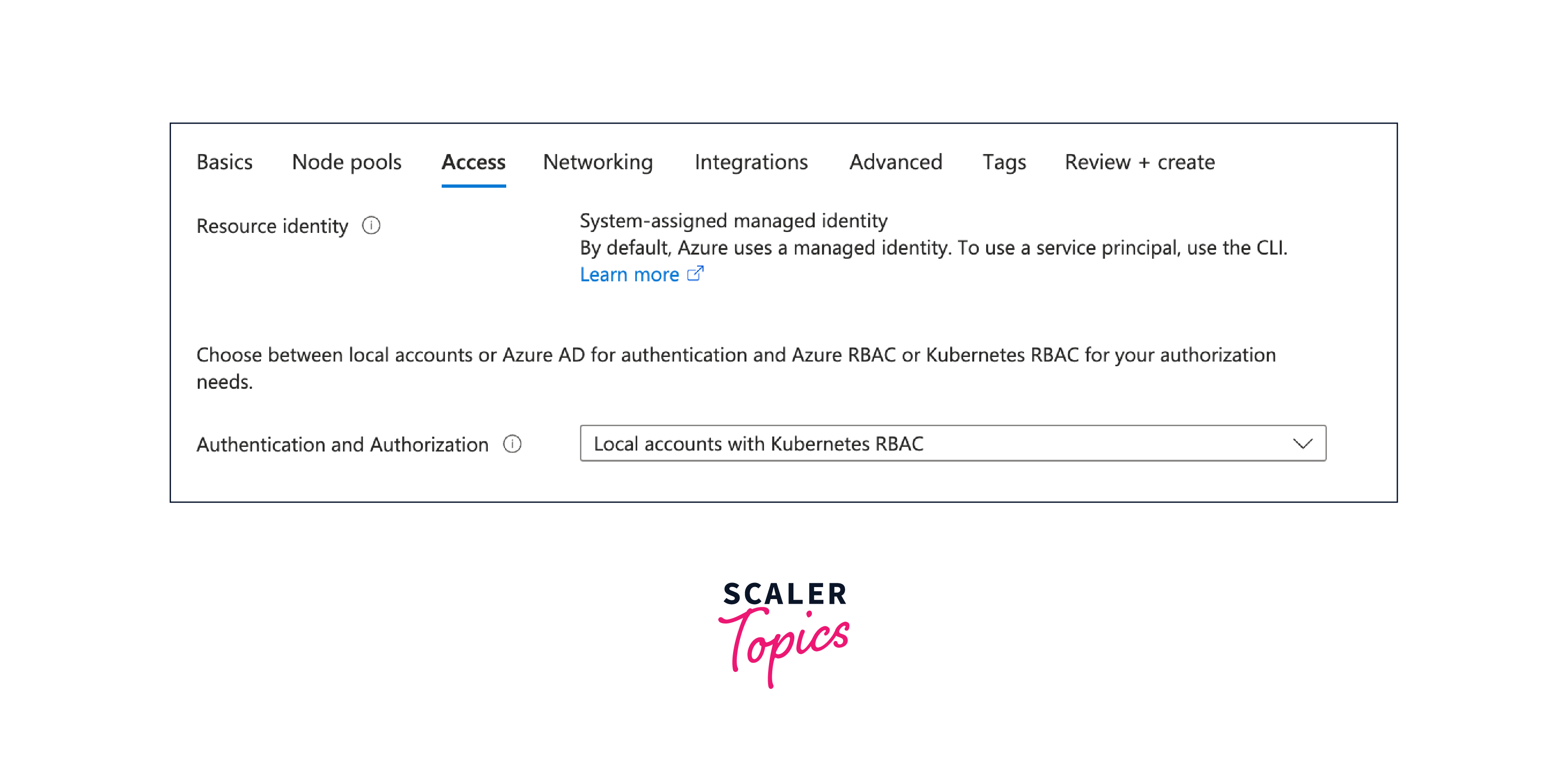
-
Now, we have to configure networking and for that, we have to set the Azure CNI.
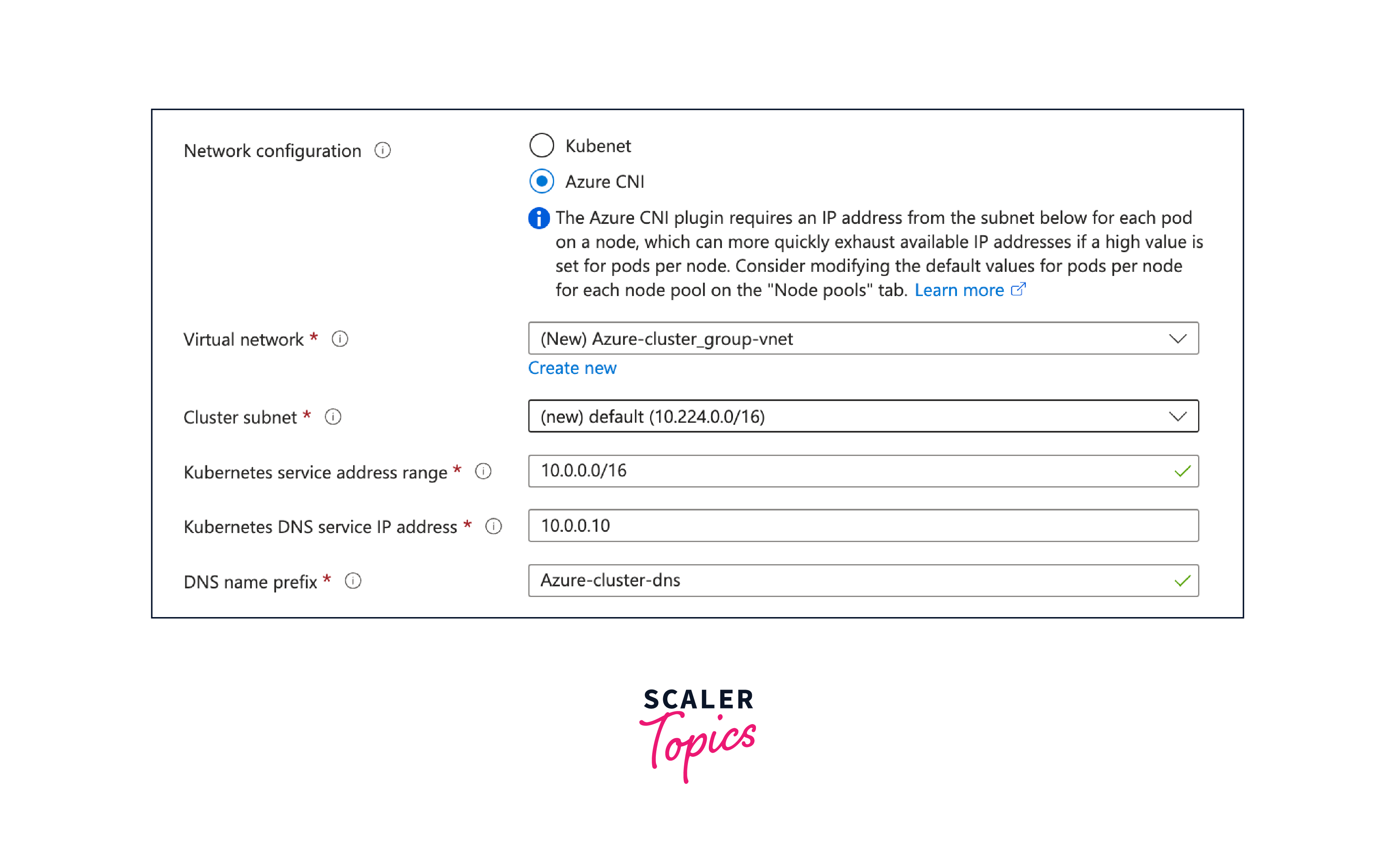
-
After these steps we have to set the networking policy.
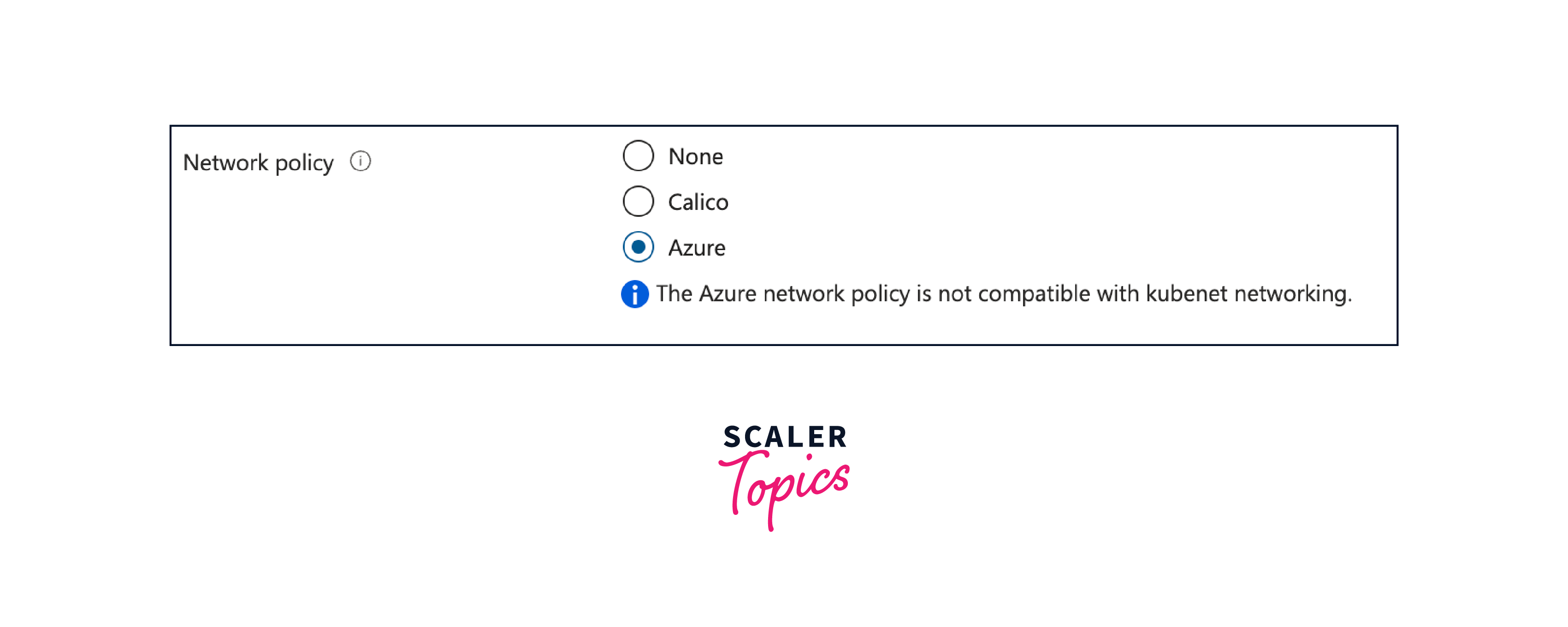
-
After doing all the steps, you can see your cluster in Kubernetes services.
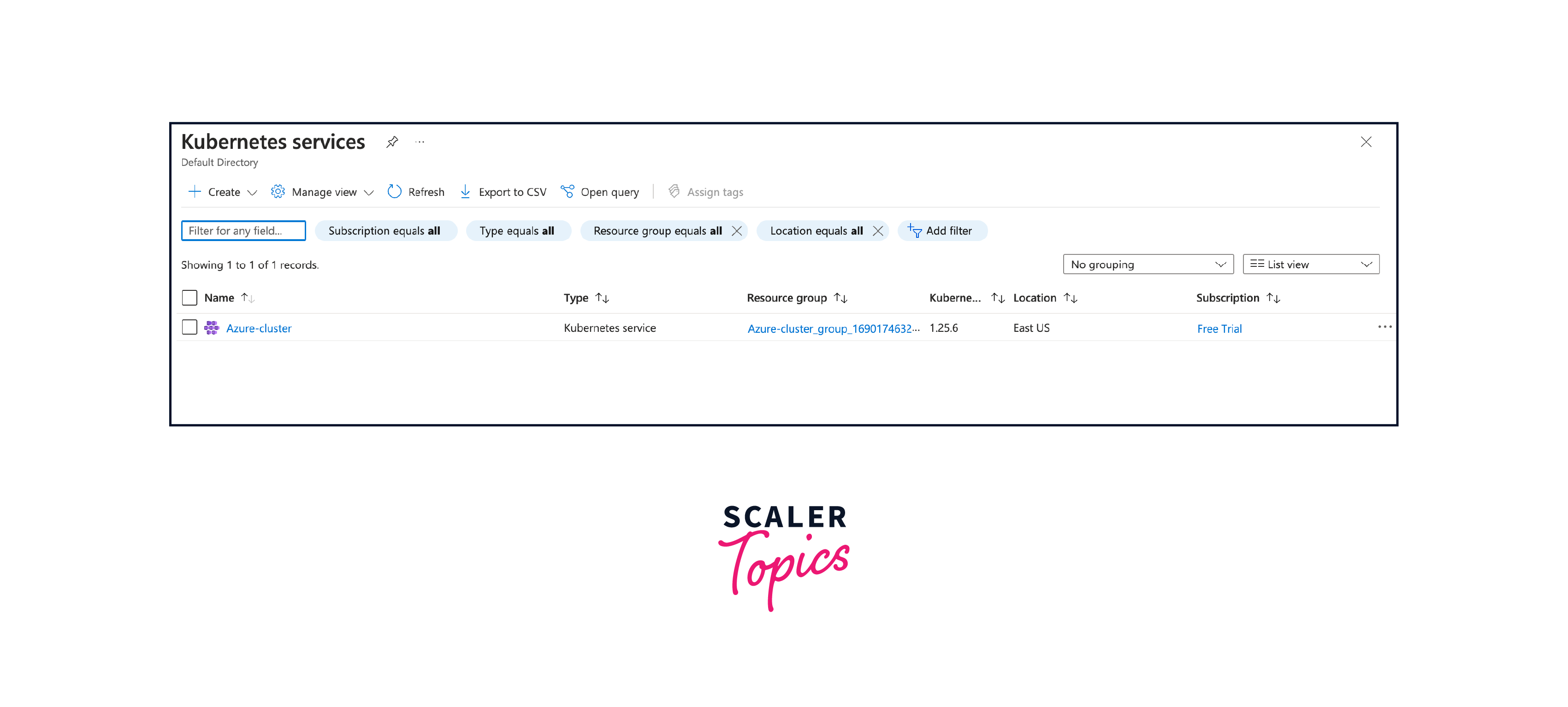
Azure Kubernetes Service Concepts
Let's learn each of the Azure Kubernetes concepts with the help of real-life analogy:
-
Control Plane:
- The Control Plane in Azure Kubernetes Service is the brain of the Kubernetes cluster, responsible for managing and maintaining the desired state of the system.
- It includes essential components like the API server, etc, scheduler, and controller manager, which work together to ensure the proper functioning of the cluster.
- The Control Plane is responsible for handling tasks such as accepting and processing API requests, scheduling pods to nodes, and monitoring the health of the cluster and its components.
- Just like an air traffic control centre at an airport, the Control Plane orchestrates the movement of resources (pods) across the cluster to ensure optimal performance and efficient utilization of resources.
-
Resource Reservations:
- Resource reservations in Kubernetes azure refer to specifying the minimum CPU and memory requirements that a container or pod needs to function properly.
- These reservations help ensure that each pod receives the necessary resources it needs to run smoothly without contention with other pods on the same node.
- For example, if a pod requires 0.5 CPU and 512 MB of memory, Azure Kubernetes Services will allocate sufficient resources on a node to meet these reservations, guaranteeing the pod's performance.
- This concept is similar to reserving seats at a restaurant; you specify the number of seats needed to accommodate your guests, ensuring everyone has enough space.
-
Node and Node Pools:
- A node in AKS is a virtual machine (VM) that acts as a worker machine in the Kubernetes cluster.
- Nodes are where containers are deployed and executed, providing the necessary compute resources to run applications.
- Node pools are groups of nodes with similar configurations, allowing users to manage nodes with varying characteristics separately.
- For instance, you can create node pools with different VM sizes to cater to different types of workloads, such as having a pool with high-performance VMs for critical applications and another with cost-effective VMs for less demanding tasks.
-
Node Selectors:
- Node selectors in Azure Kubernetes Services are used to control pod placement on specific nodes based on their labels or attributes.
- By applying node selectors to pods, you can ensure that certain pods run only on nodes with specific characteristics, such as specialized hardware or network configurations.
- For example, you may have nodes with GPUs, and you want to ensure that pods running GPU-intensive tasks are deployed only on these nodes.
- This concept is comparable to using tags on vehicles in a parking lot; you instruct drivers to park their cars in designated areas based on specific criteria, like car size or type.
Azure Networking
AKS (Azure Kubernetes Service) networking is a crucial aspect of managing containerized applications within the Kubernetes cluster. It facilitates seamless communication between different components and enables connectivity with external resources. Here are some key points about AKS networking:
-
Virtual Network (VNet): AKS(Azure Kubernetes Service) operates within an Azure Virtual Network (VNet), which provides an isolated network environment for the cluster. The VNet allows AKS nodes, pods, and services to communicate privately and securely.
-
Pod Networking: AKS(Azure Kubernetes service) uses the Container Networking Interface (CNI) plugin to enable pod-to-pod communication. Each pod is assigned a unique IP address, ensuring smooth and efficient communication within the cluster.
-
Load Balancing: Azure Load Balancer distributes incoming traffic across multiple pods in service, ensuring high availability and even load distribution. It supports both internal and external load balancing for seamless connectivity.
-
Service Networking: AKS uses Kubernetes services to expose applications to other pods or external clients. Services abstract the underlying pods, allowing dynamic IP allocation and service discovery within the cluster.
-
Network Policies: AKS supports Kubernetes Network Policies, enabling fine-grained control over network traffic between pods. Network Policies enhance security by specifying which pods can communicate with each other.
-
Azure CNI (Advanced Networking): Azure CNI provides advanced networking for AKS, allowing pods to have their IP addresses within the VNet. This option offers better performance and deeper integration with Azure networking services.
AKS(Azure Kubernetes Service) networking ensures efficient and secure communication between components, facilitating the deployment and management of containerized applications. Proper network configuration is essential for creating a scalable and resilient Kubernetes Azure environment, enabling seamless connectivity and optimal performance for your applications.
Azure Security
Azure provides a wide range of security and monitoring capabilities to assist businesses in safeguarding their cloud assets and learning more about their Azure settings. An overview of Azure's security and monitoring services is provided below:
-
Azure Identity and Access Management (IAM): By creating roles and giving individuals and groups rights, Azure Identity and Access Management (IAM) enables organisations to manage access to Azure services. This makes it possible to ensure that only individuals with permission can access sensitive resources.
-
Azure Active Directory: Azure AD enables secure single sign-on (SSO) and multi-factor authentication (MFA) for increased security. Azure AD delivers identity and access management services for cloud-based applications and services.
-
Azure Security Centre: This service provides cutting-edge threat protection, security guidance, and ongoing Azure resource monitoring. It aids in locating and fixing potential security problems across all workloads.
-
Azure Key Vault: Azure Key Vault offers a safe and convenient location for managing cryptographic secrets, keys, and certificates, shielding confidential data from unauthorised access.
-
Azure DDoS Protection: Application and service protection from distributed denial of service (DDoS) attacks is provided by Azure DDoS Protection, which also ensures high availability and minimises potential disruptions.
-
Azure Firewall: The Azure Firewall service offers centralised network security and access management for Azure resources. It is a managed, cloud-based firewall solution.
-
Azure Virtual Networks (VNets): Network Security Groups (NSGs) and Azure VNets provide for the isolation and segmentation of resources as well as detailed management of network traffic.
Azure Monitoring
-
Azure Monitor: Microsoft Azure Monitor is a centralised monitoring service that collects and analyses operational and performance data from Azure resources. It provides information regarding the infrastructure's and applications' functionality and efficiency.
-
Application Insights Application Insights is a service that monitors application performance and gives developers real-time problem-solving support.
-
Log Analytics: By collecting, storing, and analysing log data from various sources, businesses can gain meaningful knowledge about their on-premises and Azure systems.
-
Azure Metrics: Azure Metrics gives customers the ability to set up warnings and take preventative measures based on resource health by providing performance data for various Azure resources.
-
Azure Activity Log: For governance, compliance, and troubleshooting purposes, the Azure Activity Log keeps track of all actions taken on Azure resources.
Azure Kubernetes Service Pricing and Availability
Kubernetes cluster management is free because AKS is a free Azure service. Although AKS users are charged for the underlying computing, storage, networking, and other cloud resources used by the containers that make up the application running within the Kubernetes cluster, this is not the case.
The Eastern, Central, and Western United States; Central Canada; Northern and Western Europe; Southeast Asia; are only a few of the places where AKS is currently accessible. Over time, additional regions will be added.
AKS vs. Docker
| Feature | AKS | Docker |
|---|---|---|
| Platform Type | Managed Kubernetes service on Azure | Containerization platform for any platform |
| Orchestration | Fully integrated with Kubernetes | Supports Kubernetes, but not limited to it |
| Infrastructure Management | AKS handles infrastructure setup and management | Requires manual infrastructure setup |
| Scaling | Built-in auto-scaling for applications | Scaling requires manual configuration |
| Monitoring | Integrated monitoring and logging features | Monitoring tools need to be set up separately |
AKS vs. Service Fabric
| Feature | AKS | Azure Service Fabric |
|---|---|---|
| Orchestration | Fully supports Kubernetes for orchestration | Proprietary orchestration platform |
| Application Type | Ideal for containerized applications | Suitable for microservices and stateful applications |
| Programming Languages | Supports multiple programming languages | Supports multiple programming languages |
| Stateful Applications | Can manage stateful apps, but not a primary focus | Designed for seamless management of stateful apps |
| Deployment Flexibility | Deployed on cloud providers supporting Kubernetes | Can be deployed on-premises and multiple cloud providers |
| Service Discovery | Utilizes Kubernetes service discovery mechanisms | Provides built-in service discovery capabilities |
AKS vs. ACS (Azure Container Service)
AKS (Azure Kubernetes Service) is an Azure-managed Kubernetes service that specialises in Kubernetes container orchestration. AKS's predecessor, ACS (Azure Container Service), provided numerous container orchestration alternatives like Docker Swarm and Kubernetes. AKS is the preferred solution for Kubernetes-based apps because it offers better integration and management features.
FAQs
-
What is Azure Kubernetes Service (AKS)? A managed Kubernetes service is offered by Microsoft Azure under the name AKS. Developers can run containerized apps effectively in the Azure cloud environment because it makes Kubernetes cluster deployment, management, and scaling simpler.
-
What distinguishes AKS from Kubernetes? AKS is a managed service that is based on Kubernetes that abstracts away the difficulties of managing Kubernetes infrastructure. It takes care of cluster installation, upkeep, and updates, making Kubernetes cluster deployment and management simpler.
-
Which container runtimes is AKS compatible with? AKS supports Docker as the standard container runtime, which controls how containers are executed inside of pods. Container administration is made more flexible by the usage of containers as the container runtime.
-
How does AKS get paid? A separate flat price for master node management, based on the number of Kubernetes clusters, is included in the AKS payment structure. The size of your VMs and the number of nodes in your node pools are the main cost factors.
-
Can AKS automatically scale? The number of cluster nodes can be scaled automatically by AKS based on workload requirements, ensuring effective resource utilisation and cost optimisation.
Conclusion
-
AKS allows you to run and manage your cloud-based applications with ease. It handles the technical complexities, so you can focus on designing and running your apps smoothly.
-
Azure Kubernetes ensures that your applications are always accessible to users, providing a reliable and consistent experience.
-
With Azure Kubernetes, your applications are safeguarded, making sure they stay protected from potential threats and vulnerabilities.
-
Azure Kubernetes Services enables your applications to handle any amount of traffic effortlessly, so you don't have to worry about sudden spikes in user demand.
-
You can deploy, scale, and update your applications on Kubernetes Azure without the need to manage the underlying infrastructure, saving you time and effort.
-
Developer-Friendly: As a developer, AKS acts as a trustworthy assistant, taking care of tedious tasks, simplifying the development process, and making your life easier.
-
Azure Kubernetes services is an ideal companion for cloud-based modern application development, offering the necessary tools and support for building innovative and efficient applications.
